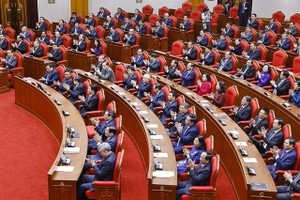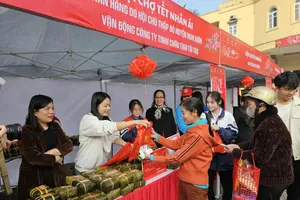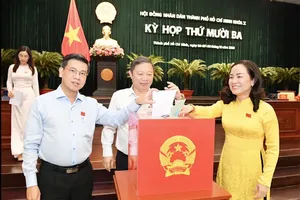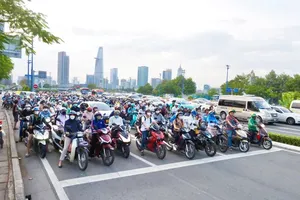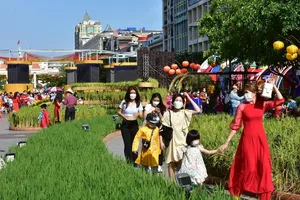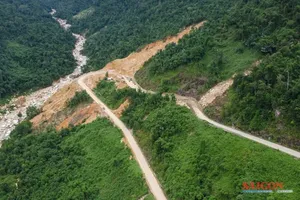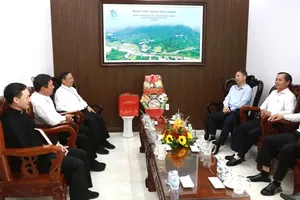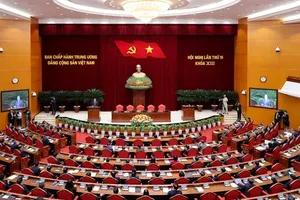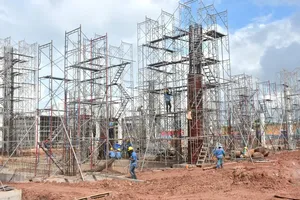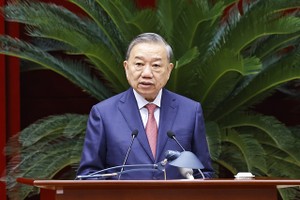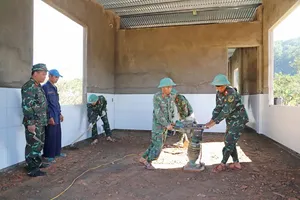Contributing to the ongoing development of Ho Chi Minh City, a key economic engine in the South and the leading metropolis nationwide, the sports sector has achieved steady progress and notable accomplishments on both domestic and international stages. Furthermore, certain enduring facilities, named in tribute to President Ho Chi Minh, reflect the city's sporting journey and its evolution through successive periods.
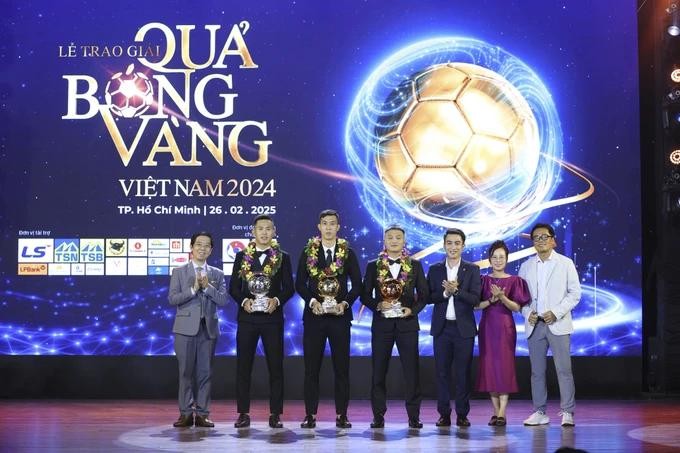
Marks of time
Saigon – Ho Chi Minh City is a melting pot of diverse cultural influences from around the world. Known for its tradition of embracing physical activity, the city's residents actively engage in sports as a means to maintain health and foster a dynamic lifestyle. As a result, sports infrastructure has consistently received strong support from leadership at all levels, reflecting the city’s broader development trajectory.
Thong Nhat Stadium in District 10 stands as a historical witness to a significant sporting milestone—the North–South football match between the General Department of Vietnam Railways and Saigon Port teams on November 7, 1976. Today, it is recognized as a symbolic landmark in the evolution of football in Saigon – Ho Chi Minh City. Beyond its long-standing history, dating back to its inauguration in 1931, this facility holds the distinction of being the only venue in Ho Chi Minh City equipped with an international-standard track and field, solidifying its role as the central headquarters for the city's track and field team.
Phan Dinh Phung Stadium in District 3 was built for the first time and put into operation in 1985, on the occasion of the 10th anniversary of national reunification. This place has witnessed many important events including 1992 Table Tennis World Cup, 1994 Badminton World Cup, 2000 Asian Taekwondo Championship, 2003 Asian Women's Volleyball Championship, nearly 20 Golden Racket Table Tennis seasons and other countless tournaments.
Phu Tho Sports Stadium in District 11 was constructed as a crucial project and emerged as one of the largest and most contemporary facilities in the Southern region in preparation for the 22nd SEA Games in 2003. This versatile stadium is capable of hosting various indoor sports competitions as well as cultural and artistic events, boasting a seating capacity of 5,000. Furthermore, the outdoor square has the capacity to accommodate up to 20,000 individuals.
Beyond physical infrastructure, a defining feature of Ho Chi Minh City's sports sector lies in its emblematic projects and events, which not only enhance the city’s image but also contribute to the broader development of national sports. One notable example is the Vietnam Golden Ball Awards, initiated and organized by SGGP Newspaper since 1995. Originally established to honor the best male football player of the year, the award has since evolved into one of the most anticipated events in Vietnamese football, held annually between the end of the year and early spring.
As it enters the 30th year, the Vietnam Golden Ball Awards has established itself as a prestigious and esteemed brand within the realm of the country's football. It serves as a significant gauge reflecting the talent and ethical standards of Vietnamese football players spanning the past three decades. The significance of the Golden Ball Awards transcends mere recognition, embodying an inspirational symbol imbued with the essence of its era. The award stands as a testament to the growth and development of numerous generations of players.
Many people hope that the city will further accelerate the development of larger-scale projects at the Rach Chiec Sports Complex to address the demand for sports facilities and accommodate future international sporting events.
Director of the Sports Authority of Vietnam Dang Ha Viet expressed his pride in the Vietnam Golden Ball Awards' evolution into an integral component of the journey towards elevating Vietnamese football to international standards. This year, the award holds special significance as it aligns with the commemoration of the 50th anniversary of the Liberation of the South and National Reunification (April 30, 1975 - April 30, 2025). He anticipates that SGGP Newspaper and its collaborators will continue to uphold and organize the selection process, recognizing Vietnamese football talents over the long term. He believes that this initiative is deserving of its status as a significant awards event within the realm of football and Vietnamese sports as a whole.
Over the past 3 decades, the Ho Chi Minh City Television Cup cycling race organized by Ho Chi Minh City Television since 1989 has always been a solid launching pad for the growth of many generations of athletes in particular, as well as contributing to promoting the journey of development and conquering new milestones for the country's sports in general.
Investment matches residents' aspirations
Despite being one of the two regions that significantly contribute to Vietnamese sports, Ho Chi Minh City's lack of hosting a major national or international sports event for several years has somewhat diminished its standing in the sports arena.
Director Tran The Thuan of the Ho Chi Minh City Department of Culture and Sports recognized that the primary issues stem from outdated facilities, insufficient professional-grade equipment, and an inability to meet the city's and its residents' fast-evolving demands. The scarcity of playgrounds, training centers, and community spaces has led to a decline in both grassroots and elite sports in Ho Chi Minh City, causing it to fall behind many other regions.
Last but not least, Ho Chi Minh City also faces difficulties in attracting social investment resources due to the lack of attractive incentive policies. The management of the playground and stadium system is currently fragmented and inefficient, resulting in a wastage of resources. Presently, the land allocation for sports facilities in Ho Chi Minh City represents only about 1.35 percent of the city's total land fund, which is lower than the national average.
Considering the ongoing expansion of sports infrastructure in other localities, Ho Chi Minh City requires a holistic and transformative strategy for its sports sector to achieve a level of development that is consistent with its economic and social importance.
2025 is anticipated to be an active and hopeful year for sports in Ho Chi Minh City, particularly as the city commemorates the 50th anniversary of the Liberation of the South and National Reunification. The local sports sector is committed to revitalizing itself in order to achieve significant advancements moving forward.
A leader of the Ho Chi Minh City Department of Culture and Sports said that the development orientation of the city's sports industry in the coming years is to promote coordination between state management agencies, public non-business units in the sports sector and the community in investing in facilities and call for more social contributions to the sector.
Nearly VND1 trillion (US$38.69 million) has been invested in upgrading and repairing infrastructure to prepare for the 2026 National Sports Festival. Since the end of 2024, Thong Nhat Stadium, Phu Tho Sports Gymnasium, Phu Tho Sports Training Center, Hoa Lu Stadium, and Phu Tho Swimming and Diving Club have gradually been repaired and upgraded.
In addition, among the 61 projects celebrating the 50th anniversary of the Liberation of the South and National Reunification, there will be a series of projects in the sports sector. Notably, the project to build a new Phan Dinh Phung Stadium is expected to start construction on the occasion of April 30.
In mid-February 2025, Vice Chairwoman of the Ho Chi Minh City People's Committee Tran Thi Dieu Thuy signed a document urging the progress of these projects. In particular, the project to renovate and upgrade Thong Nhat Stadium must urgently be submited to the Ho Chi Minh City People's Committee for adjustment of the project investment policy. The Phan Dinh Phung Stadium project needs to consider the possibility of adjusting the zoning plan and completing the pre-feasibility study report according to regulations.
In terms of projects seeking investment through the public-private partnership model, 16 out of the 21 sports projects are embedded within the Rach Chiec Sports Complex, encompassing major initiatives such as a 50,000-seat football field. Director Tran The Thuan of the Department of Culture and Sports in Ho Chi Minh City emphasized that this represents a crucial reboot following a prolonged hiatus due to planning and legal obstacles. The project was initially conceived over 20 years ago, spanning 410 hectares, but faced challenges related to land acquisition and funding, thereby hindering its execution.
In addition to the Rach Chiec Sports Complex, the initiative to construct a new Phan Dinh Phung Stadium, which received investment approval in 2008, is currently undergoing a transition to public funding. This stadium is anticipated to become the largest sports venue in the central region of Ho Chi Minh City, featuring 13 different competition categories and accommodating nearly 5,000 spectators.
